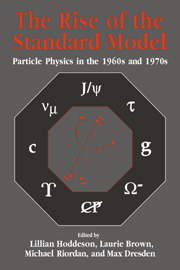Book contents
- Frontmatter
- Contents
- Contributors
- Editors' Acknowledgments
- Photographs of the Symposium
- Abbreviations and Acronyms
- Mathematical Notation
- Part One Introduction
- Part Two Quarks and Leptons
- Part Three Toward Gauge Theories
- Part Four Accelerators, Detectors, and Laboratories
- 15 The Rise of Colliding Beams
- 16 The CERN Intersecting Storage Rings: The Leap into the Hadron Collider Era
- 17 Development of Large Detectors for Colliding-Beam Experiments
- 18 Pure and Hybrid Detectors: Mark I and the Psi
- 19 Building Fermilab: A User's Paradise
- 20 Panel Session: Science Policy and the Social Structure of Big Laboratories
- 21 Some Sociological Consequences of High-Energy Physicists' Development of the Standard Model
- 22 Comments on Accelerators, Detectors, and Laboratories
- Part Five Electroweak Unification
- Part Six The Discovery of Quarks and Gluons
- Part Seven Personal Overviews
- Index
19 - Building Fermilab: A User's Paradise
Published online by Cambridge University Press: 03 February 2010
- Frontmatter
- Contents
- Contributors
- Editors' Acknowledgments
- Photographs of the Symposium
- Abbreviations and Acronyms
- Mathematical Notation
- Part One Introduction
- Part Two Quarks and Leptons
- Part Three Toward Gauge Theories
- Part Four Accelerators, Detectors, and Laboratories
- 15 The Rise of Colliding Beams
- 16 The CERN Intersecting Storage Rings: The Leap into the Hadron Collider Era
- 17 Development of Large Detectors for Colliding-Beam Experiments
- 18 Pure and Hybrid Detectors: Mark I and the Psi
- 19 Building Fermilab: A User's Paradise
- 20 Panel Session: Science Policy and the Social Structure of Big Laboratories
- 21 Some Sociological Consequences of High-Energy Physicists' Development of the Standard Model
- 22 Comments on Accelerators, Detectors, and Laboratories
- Part Five Electroweak Unification
- Part Six The Discovery of Quarks and Gluons
- Part Seven Personal Overviews
- Index
Summary
Building Fermilab was a many-faceted endeavor; it had scientific, technical, aesthetic, social, architectural, political, conservationist, and humanistic aspects, all of which were interrelated. Because the emphasis of this Symposium is on the history of science, I intend to highlight the scientific and technical aspects of the design and construction of the experimental facilities, but these other considerations were also important in building the experimental areas (Fig. 19.1). Neither the experiments made at the laboratory, nor improvements such as the Tevatron, made under the aegis of succeeding Directors, will be discussed here.
Before becoming director of Fermilab in 1967, I had been a trustee of URA since its formation in 1965. This experience had sensitized me to the growing number of particle physicists throughout the country who, with no accelerator at their home universities, had become dependent on sharing the use of larger accelerators constructed at national laboratories. It was they who started the revolt against the benevolent rule typified by the University of California's Radiation Laboratory at Berkeley and (on a smaller scale) by my own institution, Cornell University. In 1963 that arch-user Leon Lederman expressed the community's sentiments of wanting the next lab to be accessible by right for all users, that they would have a strong voice in decisions on what was built and how facilities were used, and that it would be a place where they would be “at home and loved.”
- Type
- Chapter
- Information
- The Rise of the Standard ModelA History of Particle Physics from 1964 to 1979, pp. 338 - 363Publisher: Cambridge University PressPrint publication year: 1997
- 1
- Cited by

